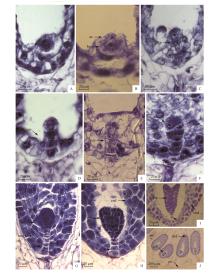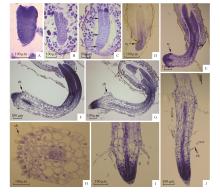Bulletin of Botanical Research ›› 2021, Vol. 41 ›› Issue (5): 675-683.doi: 10.7525/j.issn.1673-5102.2021.05.005
Previous Articles Next Articles
Wen-Ying WANG1, Qiu-Hong WANG1, Ming-Yuan LIU2, Yan SUN1( )
)
Received:2021-03-20
Online:2021-09-20
Published:2021-07-05
Contact:
Yan SUN
E-mail:sy81518@sohu.com
About author:WANG Wen-Ying(2001—),female,undergraduate,mainly engaged in the study of structural botany.
Supported by:CLC Number:
Wen-Ying WANG, Qiu-Hong WANG, Ming-Yuan LIU, Yan SUN. Morphology of Organ Development in Early Ontogeny of Gentiana scabra Bunge[J]. Bulletin of Botanical Research, 2021, 41(5): 675-683.
Add to citation manager EndNote|Ris|BibTeX
URL: https://bbr.nefu.edu.cn/EN/10.7525/j.issn.1673-5102.2021.05.005

Fig.1
Embryodevelopment of Gentiana scabraA.Zygote;B.Two-cell proembryo;C.Four-cell proembryo;D.Six-cell proembryo;E.Eight-cell proembryo;F.Club-shaped embryo;G.Globular embryo;H.Heart-shaped embryo;I.Torpedo embryo;ac.Apical cell;bc.Basal cell;ecp.Eight-celled pro-embryo;ow.Ovary wall;em.Embryo;en.Endosperm;fcp.Four-celled pro-embryo;s.Suspensor;scp.Six-celled pro-embryo;z.Zygote;The micropylar end facing down in all pictures


Fig.2
Embryo development and organ differentiation of soaked seeds in G. scabraA.Longitudinal section of seed embryos soaked in water for 2 d,showing the hydrolysis of endosperm cells around the embryo;B.Seed embryos soaked in water for 3 d,longitudinal section,showing cotyledon and hypocotyl development;C.Seed embryos soaked in water for 4 d,longitudinal section,it showed that the organs develop further,and the initial differentiation of the radicle was about to break through the seed coat;D.The embryonic axis elongated to differentiate into the radicle;E-G,I.The longitudinal section of the seed at different stages showed that the root ring and root ring hair appeared,and the radicle root tip had differentiated root cap and meristem;H.Root collet hair and root collet cross section;J.Seedling root end,showing that the root tip was fully differentiated and normal root hair appeared;c.Cotyledon;ch.Collet hairs;h.Hypocotyl;r.Radicle;rc.Root collet;rh.Root hairs


Fig.3
Seed germination process of G. scabra(scanning electron microscope)A.The radicle broke through the seed coat;B.The root ring appeared;C-E.The root ring hair and radicle;F-G.The root ring and the root ring hair were local;H.The radicle further developed and the root hair appears;I.The stoma on the cotyledon had developed;c.Cotyledon;ch.Collet hairs;h.Hypocotyl;r.Radicle;rc.Root collet;rh.Root hairs;rt.Root tip;s.Stoma

| 1 | 刘玫,王臣,刘鸣远.芡个体发育早期的研究[J].植物研究,2001,21(1):97-99. |
| Liu M,Wang C,Liu M Y.Study on the early state of ontogeny of Euryale ferox Salisb.[J].Bulletin of botanical research,2001,21(1):97-99. | |
| 2 | 谭大海,李富恒.浅谈植物发育的定义[J].民营科技,2017,11:71-72. |
| Tan D H,Li F H.A brief discussion on the definition of plant development[J].Private technology,2017,11:71-72. | |
| 3 | 刘玫,王臣,刘鸣远.泽泻个体发育早期器官发育顺序的研究[J].植物研究,2002,22(2):173-175. |
| Liu M,Wang C,Liu M Y.Study on the organic development sequence of Alisma orientale Jus.in early stage of ontogeny[J].Bulletin of Botanical Research,2002,22(2):173-175. | |
| 4 | 刘玫,王臣,刘鸣远.黑藻早期个体发育的研究[J].植物研究,2007,27(5):529-533. |
| Liu M,Wang C,Liu M Y.The ontogeny of Hydrilla verticillata(L.f.) Royle[J].Bulletin of Botanical Research,2007,27(5):529-533. | |
| 5 | 刘樱,刘玫,关旸.东北龙胆与莕菜种子至种苗发育过程的研究[J].哈尔滨师范大学自然科学学报,2002,18(5):70-73. |
| Liu Y,Liu M,Guan Y.Study on the developing process from seeds to seedlings in Gentiana manshurica Kitag.and Mymphoides peltatum O.Kuntze[J].Natural Sciences Journal of Harbin Normal University,2002,18(5):70-73. | |
| 6 | 王洪峰,王臣,刘鸣远.东北龙胆从心形胚至种子萌发时胚的发育特点观察[J].哈尔滨师范大学自然科学学报,2005,21(2):80-83. |
| Wang H F,Wang C,Liu M Y.The characteristic of development from heart-shape embryo to germnation in Gentiana manshurica[J].Natural Sciences Journal of Harbin Normal University,2005,21(2):80-83. | |
| 7 | 李庆伟,刘玫,王臣,等.大花睡莲种子至种苗的发育形态学研究[J].植物研究,2008,28(5):556-559. |
| Li Q W,Liu M,Wang C,et al.The developmental morphological of Nymphaea tetragona Georgivar.Crassifolia (Hand.-Mazz.) Y.C.Chu from seeds to seedlings[J].Bulletin of Botanical Research,2008,28(5):556-559. | |
| 8 | 孙阎,张健男,杜景红,等.金银莲花早期个体发育特性的研究[J].中国农学通报,2017,33(12):148-152. |
| Sun Y,Zhang J N,Du J H,et al.Study on the characteristics during the early stage of ontogeny in Nymphoides indica[J].Chinese Agricultural Science Bulletin,2017,33(12):148-152. | |
| 9 | 刘强,刘剑锋,程云清,等.野鸢尾种子至种苗的发育形态学[J].东北林业大学学报,2012,40(2):23-25,88. |
| Liu Q,Liu J F,Cheng Y Q,et al.Developmental morphology of Iris dichotoma from seed to seedling[J].Journal of Northeast Forestry University,2012,40(2):23-25,88. | |
| 10 | 何廷农,刘尚武,吴庆如.中国植物志:第62卷[M].北京:科学出版社,1988:104-106. |
| He T N,Liu S W,Wu Q R.Flora of China:vol.62[M].Beijing:Science Press,1988:104-106. | |
| 11 | 黄璐琦,郭兰萍,詹志来.道地药材标准汇编[M].北京:北京科学技术出版社,2020:531-532. |
| Huang L Q,Guo L P,Zhan Z L.Standard compilation of genuine medicinal materials[M].Beijing:Beijing Science and Technology Publishing House,2020:531-532. | |
| 12 | 张恩迪,郑汉臣.中国濒危野生药用动植物资源保护[M].上海:第二军医大学出版社,2000. |
| Zhang E D,Zheng H C.Conservation of endangered medicinal wildlife resources in China[M].Shanghai:Second Military Medical University Press,2000. | |
| 13 | 张为江,杨立珂.龙胆草引种栽培[J].中草药,1980,11(11):514. |
| Zhang W J,Yang L K.Ingrowing and cultivation of Gentiana scabra[J].Chinese Herbal Medicine,1980,11(11):514. | |
| 14 | 郝赤松,张宁.东北龙胆的栽培技术[J].中草药,1983,14(11):35-36. |
| Hao C S,Zhang N.Cultivation technology of Gentiana manshurica[J].Chinese Herbal Medicine,1983,14(11):35-36. | |
| 15 | 刘鸣远,李春荣,崔雅娟,等.“关龙胆”繁殖方法的研究[J].中草药,1984,15(1):34-35,37. |
| Liu M Y,Li C R,Cui Y J,et al.Research on the breeding method of Guanlongdan[J].Chinese Herbal Medicine,1984,15(1):34-35,37. | |
| 16 | 孙阎,王臣,刘樱,等.关龙胆三种原植物及其变异的杂交初报[J].哈尔滨师范大学:自然科学学报,2003,19(5):99-101. |
| Sun Y,Wang C,Liu Y,et al.The primary report of cross-breeding between three original species of Guan-longdan and their variations[J].Natural Sciences Journal of Harbin Normal University,2003,19(5):99-101. | |
| 17 | 孙阎,王臣,刘鸣远.关龙胆开花结实生物学特性[J].植物研究,2003,23(4):453-457. |
| Sun Y,Wang C,Liu M Y.The biological characters of flowering and fruiting of Guanlongdan[J].Bulletin of Botanical Research,2003,23(4):453-457. | |
| 18 | 顾小琳,逯子佳,张欣欣,等.粗糙龙胆根系发育形态学研究[J].中国农学通报,2019,35(18):30-35. |
| Gu X L,Lu Z J,Zhang X X,et al.Root development of Gentiana scabra:morphological study[J].Chinese Agricultural Science Bulletin,2019,35(18):30-35. | |
| 19 | 施国新,徐祥生.慈菇下胚轴毛的形态发育研究[J].广西植物,1989,9(2):113-116. |
| Shi G X,Xu X S.Studies on the developmental morphology of hypocotylar hairs of Sagittaria sagittifolia L.[J].Guihaia,1989,9(2):113-116. | |
| 20 | 胡适宜.被子植物生殖生物学[M].北京:高等教育出版社,2005. |
| Hu S Y.Reproductive biology of angiosperms[M].Beijing:Higher Education Press,2005. | |
| 21 | DAVIS G L.Systematic embryology of the angiosperms[M].New York:John Wiley & Sons Inc.,1966. |
| 22 | 朱雪红,申家恒.东北龙胆的受精作用及其胚和胚乳的发育(Ⅱ)[J].哈尔滨师范大学自然科学学报,1989,5(4):58-67. |
| Zhu X H,Shen J H.Fertilization and the development of Endosperm and Embryo of Gentiana manshurica(Ⅱ)[J].Natural Sciences Journal of Harbin Normal University,1989,5(4):58-67. | |
| 23 | 何廷农,刘建全.线叶龙胆的胚胎学研究[J].西北植物学报,1999,19(2):234-240. |
| He T N,Liu J Q.Embryology of Gentiana lawrencei var.farreri[J].Acta Botanica Boreali-Occidentalia Sinica,1999,19(2):234-240. | |
| 24 | 何廷农,陈世龙,刘建全,等.条纹龙胆的胚胎学研究[J].西北植物学报,2000,20(6):960-967. |
| He T N,Chen S L,Liu J Q,et al.Embryology of Gentiana striata(Gentianaceae)[J].Acta Botanica Boreali-Occidentalia Sinica,2000,20(6):960-967. | |
| 25 | 李惠娟,王耀芝.秦艽的胚胎学研究[J].西北植物学报,1994,14(4):243-248. |
| Li H J,Wang Y Z.Embryological studies in Gentiana macrophylla[J].Acta Botanica Boreali-Occidentalia Sinica,1994,14(4):243-248. | |
| 26 | 刘建全,何廷农.黑边假龙胆的胚胎学研究[J].云南植物研究,1996,18(2):151-158. |
| Liu J Q,He T N.Embryological Studies of Gentianella azurea[J].Acta Botanica Yunnanica,1996,18(2):151-158. | |
| 27 | 刘建全,何廷农.喉毛花的胚胎学研究[J].植物分类学报,1996,34(6):577-585. |
| Liu J Q,He T N.The embryological studies of Comastoma pulmonarium(Gentianaceae)[J].Acta Phytotaxonomica Sinica,1996,34(6):577-585. | |
| 28 | 刘建全,何廷农.湿生扁蕾的胚胎学研究[J].高原生物学集刊,1997,13:31-41. |
| Liu J Q,He T N.Embryological of Gentianopsis paludosa (FR.) MA[J].Acta Biology Plateau Sinica,1997,13:31-41. | |
| 29 | 何廷农,薛春迎,刘建全.红直獐牙菜的胚胎学[J].西北植物学报,1999,19(1):76-80. |
| He T N,Xue C Y,Liu J Q.Embryology of Swertia erythrosticta Maxim[J].Acta Botanica Boreali-Occidentalia Sinica,1999,19(1):76-80. | |
| 30 | 茹剑,刘玫,王臣,等.龙舌草果实和种子及其种苗发育形态学研究[J].西北植物学报,2013,33(1):22-26. |
| Ru J,Liu M,Wang C,et al.Morphological Study of fruit seed and seedling development of Ottelia alismoides Hydrocharitaceae[J].Acta Botanica Boreali-Occidentalia Sinica,2013,33(1):22-26. | |
| 31 | Haines R W,Lye K A.Seedlings of nymphaeaceae[J].Botanical Journal of the Linnean Society,1975,70(3):255-265. |
| 32 | Parsons R F.Hypocotyl hairs:an historical perspective[J].Australian Journal of Botany,2009,57(2):106-108. |
| 33 | Parsons R F.Adaptations to floodplains in Populus and Salix:the role of collet hairs[J].Trees,2013,27(1):1-5. |
| 34 | Sliwinska E,Mathur J,Bewley J D.On the relationship between endoreduplication and collet hair initiation and tip growth,as determined using six Arabidopsis thaliana root-hair mutants[J].Journal of Experimental Botany,2015,66(11):3285-3295. |
| [1] | Yingying TANG, Chuanchao GUO, Dang SHI, Nanlin JIANG, Zheng XU, Liqiang LIU. Effects of Pulp and Buried Depth on Seed Germination and Seedling Growth of Armeniaca vulgaris [J]. Bulletin of Botanical Research, 2023, 43(2): 251-260. |
| [2] | Huan WANG, Yunfei XU, Yibo LIU, Qinsong LIU, Wenjuan XU, Yun LONG, Xiao XU. Allelopathic Effects on Seed Germination and Seedling Growth of Brassica pekinensi, Caused by Water Extracts of Branches and Leaves from Davidia involucrata and Bothrocaryum controversum [J]. Bulletin of Botanical Research, 2022, 42(5): 866-875. |
| [3] | Dan WANG, Ya-Qi LI, Ji-Wei SUN, Jiang-Fei LI, Shi CHEN, Yu-Lan XU, Nian-Hui CAI. The Allometry Growth of Pinus yunnanensis Seedlings from Different Families [J]. Bulletin of Botanical Research, 2021, 41(6): 965-973. |
| [4] | Guo-Yu SUN, Xiao-Yu MA, Jia-Xin YI, Fang-Ping ZHANG, Chun-Hua ZHANG, Kai-Long LI. Effects of Nutrient Supply on Growth Dynamics and Nutrient Allocation of Poplars [J]. Bulletin of Botanical Research, 2021, 41(5): 690-699. |
| [5] | Yue ZHANG, Quan-Ling ZHANG, Zhi HONG, KAN Zi-Han, Zhao-Yue CHU, Ye TAO. Intraspecific and Interspecific Allelopathy of Invasive Plants Plantago virgica and Daucus carota [J]. Bulletin of Botanical Research, 2021, 41(3): 441-448. |
| [6] | Rui-Qing HE, Yun-Yao YANG, Zeng-Hui HU, Jing WU, Ping-Sheng LENG. Variation of Flower Phenotypic Traits on 195 Syringa oblata SeedSeedings Single Trees [J]. Bulletin of Botanical Research, 2021, 41(2): 213-220. |
| [7] | Wei LONG, Xiao-Hua YAO, Le-Yan LÜ. Dynamic Changes of Endogenous Hormones in Rootstocks and Scions within Nurse Seedling Graft in Camellia oleifera Under Wound [J]. Bulletin of Botanical Research, 2021, 41(2): 232-242. |
| [8] | XIAO Zhi-Peng, YIN Chong-Min, GUO Lian-Jin, WU Yuan-Rong, HU Jin-Ping, LIU Yan-Yan, ZHONG You-Chun, XUE Ping-Ping. Effect of Light Quality on Seed Germination and Seeding Growth of Emmenopterys henryi [J]. Bulletin of Botanical Research, 2020, 40(2): 189-195. |
| [9] | LIU Ting-Yan, HAO Long-Fei, WANG Qing-Cheng, BAI Shu-Lan. Effects of Different Planting Densities on Cultivating Quality of Padus maackii Seedlings [J]. Bulletin of Botanical Research, 2019, 39(6): 863-868. |
| [10] | XU Hai-Jun, CHENG Xin-Yu, WANG Xiao-Fei, GUAN Xiang-Jun. Effects of Different Nitrogen Level on Growths of Moringa oleifera Seedling under Northern Facilities of China [J]. Bulletin of Botanical Research, 2019, 39(1): 54-60. |
| [11] | LÜ Dong, ZHANG Hong-Bin, LI Bing-Xin, ZHAO Hu. Phenotypic Traits of Half Sibs-seeds and Their Offspring Seddlings on Picea crassifolia Superior Individual Trees [J]. Bulletin of Botanical Research, 2018, 38(3): 377-383. |
| [12] | YAO Xiao-Lan, ZHOU Lin, FENG Mao-Song, HAO Jian-Feng, RAO Yuan-Lin, YAO Jun-Yu, QI Jin-Qiu. Effects of Drought Stress on the Growth and Biomass of Phoebe zhennan'seedling in Different Substrates Net Container [J]. Bulletin of Botanical Research, 2018, 38(1): 81-90. |
| [13] | LIU Jian-Xin, LIU Xiu-Li, WANG Jin-Cheng, JIA Hai-Yan. Effect of Ca2+ on Seed Germination and Seedling Formation of Oat Induced by H2O2 under Saline-Alkali Complex Stress [J]. Bulletin of Botanical Research, 2017, 37(6): 855-860. |
| [14] | JIANG Yong, HU Shang-Lian, CAO Ying, LU Xue-Qin, HUANG Yan, XU Gang. Effects of Exogenous GA3 on the Growth of Stem and CesA Gene Expression in Phyllostachys edulis Seedling [J]. Bulletin of Botanical Research, 2017, 37(5): 744-750. |
| [15] | MA Xing-Yu, LI Mei, JIN Wen-Yun, CHEN Zu-Xu, HUANG Shi-Neng. Natural Regeneration Characteristics of Archidendron clypearia [J]. Bulletin of Botanical Research, 2017, 37(5): 761-767. |
| Viewed | ||||||
|
Full text |
|
|||||
|
Abstract |
|
|||||